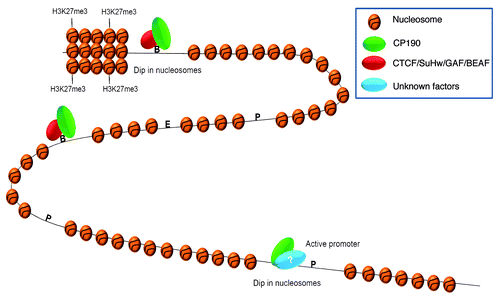Figures & data
Figure 1. CP190 and the global organization of chromatin. CP190 acts as a mediator for dCTCF and Su(Hw) class of insulators by blocking enhancer-promoter communication. CP190 binds to active promoters which inversely correlate with nucleosome occupancy by unknown mechanisms. This trend is also seen at the borders of H3K27me3. Moreover, CP190 has many binding sites throughout the genome that do not overlap with any of the known insulator binding proteins. P, promoter; E, enhancer; B, boundary; ?, indicates an unknown protein partner.

Figure 2. Schematic of the full-length Centrosomal Protein 190 (1,096 amino acid residues). CP190 contains BTB/POZ domain at the N-terminus, D-rich, CENT and zinc-finger (Zn) domains in the center and an E-rich domain at the C-terminus. Function of each domain is described in the text.

Figure 3. CP190 is a common co-factor for four classes of insulators in Drosophila. Each class of insulator is represented by the DNA binding factor dCTCF, Su(Hw), GAF and BEAF, color coded differently to indicate insulator subclasses. CP190 is shared by all the insulator classes, although in case of GAF, its functional relevance is yet to be determined. CP190 is also found to associate with factors like Rm62, dTopors, Ago2, implicated in insulator function. In addition to CP190, insulator subclasses may also share Mod(mdg4). Furthermore, all the above classes of insulators may also share other co-factors that are yet to be identified.

Figure 4. CP190 facilitates chromatin looping interactions. Insulator complexes of which CP190 is a key component, mediate intra- or inter-chromosomal interactions. Such looping interactions are thought to result in relocation of target loci to a repression compartment [such as Polycomb group (PcG) bodies] or an activation compartment (transcription factories). In the schematic, CP190 is shown as green ovals. Red, orange and blue ovals represent other insulator associated proteins. Red and blue lines indicate regions of two different chromosomes.
![Figure 4. CP190 facilitates chromatin looping interactions. Insulator complexes of which CP190 is a key component, mediate intra- or inter-chromosomal interactions. Such looping interactions are thought to result in relocation of target loci to a repression compartment [such as Polycomb group (PcG) bodies] or an activation compartment (transcription factories). In the schematic, CP190 is shown as green ovals. Red, orange and blue ovals represent other insulator associated proteins. Red and blue lines indicate regions of two different chromosomes.](/cms/asset/d733eadb-48d2-4436-8cdc-12c9dbf23b85/kncl_a_10923389_f0004.gif)